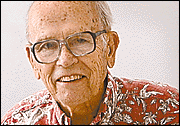Advertisement - Click to support our sponsors.


Hawaii’s World
EARLY in the 20th century, Hawaii had more than 1,000 leprosy patients isolated involuntarily -- like criminals -- at Kalaupapa, Molokai. Access was only by sea or via a steep trail up a cliff. Elimination of
leprosy is in sightEven after World War II the involuntary population was around 250. Today it is down to 48 voluntary residents, mostly older people disfigured and/or disabled before drug therapies began to bring the dreaded disease under control.
Today it is exciting to read a World Health Organization report that the final push is under way toward the elimination of leprosy worldwide by the year 2005. "Elimination" means the reduction in prevalence to less than one case per 10,000 population in every nation. This, WHO said, is within reach by 2005. It has issued a strategic plan to do just that.
At its core will be multidrug therapy (MDT). It can bring the disease under control in four or five days if found in its early stage. There will be no contagion, no disfigurement. Patients under treatment can lead normal lives.
In Hawaii there is no longer even any need to report to the state Health Department's Hansen's Disease Center at Leahi Hospital in Honolulu. Primary care is mainstreamed through private physicians -- a development in which the state Health Department takes particular pride.
About 290 patients are being treated in this way. Most are migrants from Pacific islands where the disease still persists, as it does in Africa, Asia and South America. They are identified at the rate of 20 to 25 a year and put under treatment.
Under state statute, leprosy still is referred to as Hansen's Disease, a step intended to reduce stigma also introduced in other areas. WHO, however, always has called it leprosy.
No stigma is warranted today. Hawaii, however, recognizes an obligation to those involuntarily confined -- some from childhood -- before drug therapies eliminated the possibility of spreading the disease.
Even this possibility, it's now known, was limited to Hawaiians primarily. Europeans and many Asians had developed a genetic resistance from survivors of long-ago scourges. There are some poignant Hawaii cases of spouses failing to get leprosy, even by direct blood transfer, so they could join their mates in Kalaupapa.
For the 48 oldsters who still choose to live at Kalaupapa under state and federal auspices, Leahi Hospital maintains a 21-bed clinic that treats infirm patients and also can be used as a hotel by Kalaupapa residents on Honolulu visits.
It is called the Hale Mohalu clinic, after a clinic formerly located at Pearl City and finally closed by the Health Department amid great controversy.
Much of the world knows of Kalaupapa because of the 19th century ministry there by Father Damien DeVeuster. After nine years on the Big Island, he chose in 1973 to join the Kalaupapa patients at the time of their greatest stigma. A Belgian by birth, he became a rare European victim of the disease himself and died among his fellow exiles on April 15, 1889. He was beatified by the Vatican in 1995. Sainthood is possible if Vatican research now under way can prove a Damien miracle.
Before drugs, the disease often started its insidious path through the body by wiping out the sensitivity to pain of patients in such a way that they might, for instance, burn or hammer on a hand or foot without feeling it. Thus was lost the protection from serious injury that pain can bring. Leprosy alone is rarely fatal -- thus the long survival of many victims.
WHO estimates that leprosy today affects over 1 million people in the areas not yet fully controlled and that 2 million to 3 million remain permanently disabled as a result of it.
A.A. Smyser is the contributing editor
and former editor of the the Star-Bulletin
His column runs Tuesday and Thursday.